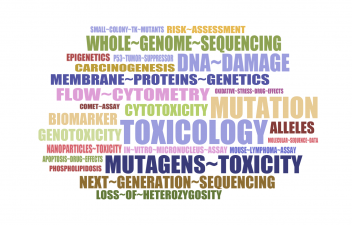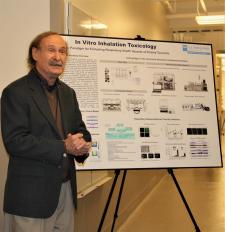NCTR Division of Genetic and Molecular Toxicology Also referred to as: DGMT
Division Director: Robert Heflich, Ph.D.
About the Division
The Division of Genetic and Molecular Toxicology (DGMT) is internationally recognized for its expertise in developing and validating genetic-toxicity assays and in interpreting genetic toxicity findings for regulatory decision-making.
- Develop and validate regulatory genetic-toxicology assays.
- Conduct chemical-specific research.
- Develop new paradigms for regulatory decision-making that integrate measures of genetic risk with biomarkers of toxicity by conducting research to develop:
- Relevant biological models.
- Comprehensive approaches to monitor genetic variation using technologies such as Next Generation Sequencing.
- Better ways of evaluating data to determine human risk.
Division scientists actively participate in FDA committees and international working groups that form consensus on how to conduct regulatory genetic-toxicology testing. International working groups include: International Workshop for Genotoxicity Testing (IWGT), the Organization for Economic Cooperation and Development (OECD), and the Health and Environmental Sciences Institute (HESI). Division scientists will continue to be involved in discussions concerning the appropriate strategies for conducting risk-assessments of regulated products.
- Engage FDA product centers (CDER, CBER, CDRH, CVM, CTP), NIEHS/National Toxicology Program, Health and Environmental Science Institute (HESI) and other national and international organizations to set research priorities.
- Develop better biological models for assessing human risk (3-D human in vitro systems).
- Develop more comprehensive approaches for monitoring genetic variation (Allele-specific Competitive Blocker-Polymerase Chain Reaction [ACB-PCR], Next Generation Sequencing [NGS], Digital Display-Polymerase Chain Reaction [ddPCR]).
- Develop better ways of evaluating data to determine human risk (Dose response curves, Bench Mark Dose [BMD], Point of Departure [POD]).
2020 Select Accomplishments
Using TK-6 Cells to Evaluate Pyrrolizidine Alkaloid-Induced Genotoxicity
- Engineered TK-6 cells to express 14 different human cytochrome P450s for screening genotoxicity of xenobiotics. Using these metabolically competent TK-6 cells, scientists were able to evaluate pyrrolizidine alkaloid-induced genotoxicity. Project collaboration with NIEHS and CVM. Toxicological Sciences and Food and Chemical Toxicology.
Expertise in Common Regulatory Genetic Toxicology Assays
DGMT scientists on the CDER Genetic Toxicology Subcommittee of the Pharmacology/Toxicology Coordinating Committee are consulted on a regular basis for evaluation of genetic toxicology data. Division members have hands-on expertise in conducting all of the common regulatory genetic toxicology assays (e.g., Ames, TGR, Comet, and Pig-a):
- Performed high-throughput CometChip assays in primary human hepatocytes (PHH) and two in vitro human hepatoma cell lines using 16 chemicals with different genotoxic modes of action. DNA damage responses among the three different cell types were compared and results demonstrated that 1) the CometChip is a viable high-throughput assay for PHHs and 2) PHHs had higher sensitivity than either HepaRG or Hep-G2 cells for detecting genotoxic carcinogens. Collaboration with CDER. Archives of Toxicology.
- Provided recommendations for conducting the rodent erythrocyte Pig-a assay to measure in vivo somatic cell mutation for regulatory purposes. Recommendations on best practices for designing and conducting rodent Pig-a studies in support of evaluating test substance safety are described in a report from the Pig-a Workgroup of the Health and Environmental Sciences Institute/Genetic Toxicology Technical Committee. Collaboration with Organization for Economic Co-operation and Development (project number 4.93).
- Demonstrated that procarbazine and N-propyl-N nitrosourea are rodent mutagens and induce Pig-a mutant phenotypes in red blood cells (RBCs). To prove the RBC mutant phenotype have Pig-a mutations, error-corrected next generation sequencing was performed on the precursors of RBCs—bone marrow erythroid cells (BMEs)—from rats exposed to these mutagens. The agent-specific mutational spectra in BMEs indicated that the rat RBC Pig-a assay scoring Pig-a mutant-phenotype RBCs in peripheral blood detects Pig-a gene mutation. Collaboration with CDER. Environmental Molecular Mutagenesis.
- Evaluated cytotoxicity and genotoxicity of cadmium oxide nanoparticles (CdO NPs) in vitro. CdO NPs are among the most studied and industrially used metal oxide NPs. The results showed that CdO NPs induced concentration-dependent cytotoxicity in TK-6 and HepG2 cells. In addition, CdO NPs were genotoxic in several assays, producing positive responses in micronucleus, Comet, and mouse lymphoma assays. Collaboration with UALR, CVM, and ORA. Mutation Research.
Using Models to Conduct Research on Lung Cancers and Respiratory Toxicants
- Developed methods for the preparation and growth of spheroids from primary human lung adenocarcinomas to evaluate erlotinib-resistant subpopulations in patient-derived lung tumor spheroids. The ex vivo lung tumor spheroid model mimicked the cellular and mutational tumor heterogeneity of human lung adenocarcinomas, indicating that spheroid cultures could be used to investigate the efficacy of lung cancer combination therapies. Collaboration with Osaka Medical Center for Cancer and Cardiovascular Diseases, Osaka, Japan. PLoS ONE.
- Used acrolein as a model toxicant in normal human lung bronchial epithelial cells and human lung cancer cells for evaluating the dosimetry and key adverse responses. The study suggested that the cell susceptibility to acrolein exposure is closely associated with acrolein uptake and formation of GSH-ACR adducts. The study concluded that dosimetry analysis might be useful for computational modeling and risk assessment of acrolein using different test systems. Collaboration with CTP. Environmental Toxicology and Pharmacology.
- Reviewed the properties and utility of human air-liquid-interface (ALI) organotypic airway tissue models derived from primary tracheobronchial epithelial cells for performing toxicological studies. The review indicated that ALI tissue models, because of their in vivo-like structure and functions when they fully differentiate, can be used for conducting in vitro exposures that mimic human respiratory exposures. It was suggested that although toxicity evaluations using ALI models require further validation, these models potentially can supplement or replace animal models for conducting research on respiratory toxicants and pathogens. Collaboration with NIOSH and NIEHS. In Vitro Cellular & Developmental Biology - Animal.
Cancer Driver Mutations (CDMs) as Biomarkers
- Reviewed the COSMIC database for mutational hotspots within the 20 most mutated genes across the 10 deadliest cancers. This survey was used to identify the most promising targets to investigate CDMs as biomarkers for use in cancer risk assessment. The review provided a roadmap for the development of tissue-specific, CDM-based biomarkers of carcinogenic potential, which could be measured by error-corrected next-generation sequencing. Using this information, they further developed and validated an error-corrected next-generation sequencing method, “CarcSeq”, to analyze panels of hCDMs. CarcSeq appears to be a promising approach to advance cancer risk assessment and carcinogenicity testing practices. Environmental Molecular Mutagenesis: January 2020 and September 2020.
Select Projects in 2021
In collaboration with CBER, NCTR scientists received two years of PHCE funding to develop a human in vitro transplacental model of drug transport.
- Two collaborative projects with CBER received MCMi funding for:
- Continuing development of a microphysiological system for evaluating Zika virus sexual transmission using a non-human primate testicular model.
- Development of a microphysiological system for evaluating antibody therapies targeting Zika viral infections during pregnancy.
Resources For You
Contact Us
- NCTR
- National Center for Toxicological Research
Food and Drug Administration
3900 NCTR Rd
Jefferson, AR 72079
-
Hours Available
- (870) 543-7121


